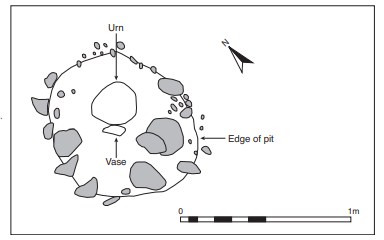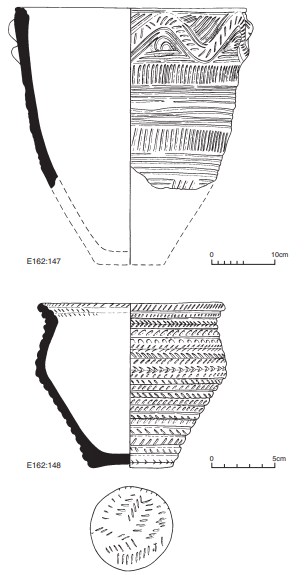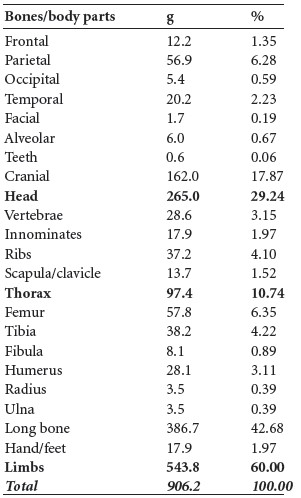County: Meath Site name: NEVINSTOWN, CO. MEATH
Sites and Monuments Record No.: SMR no. ME025-043001SMR ME025-043002 Licence number: E162
Author: MARY CAHILL
Site type: Early Bronze Age graves
Period/Dating: —
ITM: E 684955m, N 768760m
Latitude, Longitude (decimal degrees): 53.661698, -6.714601
Introduction
In July 1977, during the excavation254 of a multi-ditched enclosure of early medieval date, a pit burial containing an encrusted urn and a vase was discovered. The base and lower part of the inverted urn had been damaged, perhaps by the later activity on the site, but the vase remained intact. The pit was discovered in the southern part of the habitation enclosed by the innermost ditch. The cremated remains represented an adult and a juvenile. The cremation deposit was examined by Barra Ó Donnabháin.
Location (Fig. 3.139)
The site is in the townland of Nevinstown,255 2.2km north-west of Navan. The enclosure, which took the form of an artificial low mound within three concentric ditches, was built at the end of a ridge overlooking the Blackwater River. Although not at any great height, being located between the 40m and 50m contours, the site has a very extensive view of the surrounding countryside to the south, east and west. The southern and south-western sides of the ridge are very steep, while there is a very gradual slope towards the end of the ridge from the eastern side.256 Given the location, the discovery of an early Bronze Age burial is perhaps not surprising and raises the possibility that there may have been other burials on the ridge, in areas which either were not excavated or were destroyed when the later ditches and interior were built.
Description of site
The pit was discovered during trowelling of an area of the enclosure within the cutting noted as S2 (Fig. 3.140), within the inner ditch. As trowelling proceeded in this area, the broken rim of a ceramic vessel was observed. This was the remains of the upper portion of an encrusted urn; the lower third or so and the base had been damaged and partly destroyed at some unknown stage, perhaps connected with the building of the mound and enclosure. The pit was differentiated from the surrounding habitation layer by a fill of yellow clay. When about 0.2m of the fill of the


pit was removed, an intact bipartite vase lying on its side, mouth downwards with part of its base leaning at an angle against the urn, was found on the southern side of the pit. The mouth of the vase was against the wall of the pit. The vase contained a small quantity of cremated bone. Under the vase a deposit of soft red clay was found. This material was soft and malleable and c. 0.05m thick. It did not occur elsewhere in the pit.
The pit was approximately circular in outline and measured 0.63m in diameter at its widest. There were some large stones irregularly placed around its edges. The fill consisted of yellow clay but was softer in consistency than the surrounding natural yellow boulder clay from which it was derived. It was mixed with grey soil and was slightly darker in appearance than the subsoil. Other large stones were found throughout the fill of the pit and were probably part of the original material dug out to make the pit. The urn was placed at a slight angle on the ground rather than flat on the floor of the pit. The southern side of the rim was c. 0.05m lower in the ground than the northern side.
Inside the urn was a fill of grey/brown very coarse sand with some pebbles. Within this fill were found some sherds of the urn, which had broken presumably during the earlier disturbance of the pit. It was noted that this sandy fill was quite different from the surrounding subsoil and the later habitation layer that covered the pit and the top of the vessel. At a depth of c. 0.3m, within the urn, cremated bone (E162:149.8) and ash were discovered, mixed to some degree with the sandy fill, although there were some concentrations of bone within this which were removed as separate samples. It therefore appears that the urn was filled with the sandy material followed by the more substantial cremated remains. Owing to the disturbance of the site, some sherds from the urn became mixed with the fill of the lower part of the vessel. As it has not been possible to fully reconstruct the urn, some of the missing sherds must have been lost at that time. The cremation deposit was carefully gathered up; it represented the remains of a robust adult male and a child of five to ten years.
Pottery
Encrusted urn, E162:147 (Fig. 3.141)
This urn was quite badly damaged when discovered, as it has suffered the loss of its lower body and base, presumably during the building of the later enclosure. Nonetheless, it is clear that it was a substantial vessel with thick walls. The rim is slightly curved in the inside and is decorated with three circumferential grooves. On the external rim there is a single groove, below which a panel of encrustations commences. This consists of a running moulding forming a chevron with bosses between the angles of the chevron. The bosses and the chevron moulding are decorated with deep scores, while the spaces between the raised elements have all been outlined by shallow grooving set out as triangles around the bosses or as groups of lines.
The decoration on the body of the vessel follows a pattern that begins with a panel of vertical rounded impressions, then an irregular panel of circumferential shallow grooves, followed by a wide, slightly raised band, below which is an irregular panel of circumferential shallow grooves. The pattern begins to repeat itself but the remaining panels do not survive.
Dimensions: H (surviving max.) 28cm; ext. D rim 32cm; int. D rim 29.4cm; T wall 1.7cm.
Bipartite vase, E162:148 (Fig. 3.141)
The bipartite vase is complete, except for some loss of the rim where it was in contact with the bottom of the pit. It has an everted rim decorated with two deep circumferential grooves forming three raised mouldings, which are decorated with short slanted impressions. The entire body of the vessel is similarly grooved, resulting in an all-over pattern consisting of deep horizontal grooves with impressed short lines on the intervening ridges, some forming herringbones. The base is decorated with an irregular pattern of short oblique lines, some forming interlocking V-shapes.
Dimensions: H 12.93; ext. D rim 14.5cm; int. D rim 11.3cm; D base 6.7cm.

Lithics (Pl.53)
Two flakes were found, one retouched flint flake (E162:149.1) and one of unworked limestone or chert (E162:149.2). The flint flake is retouched on both long sides; L 2.8cm; W 1.45cm. The chert flake is unworked but pointed at one end; L 2.9cm; W 1.06cm.
Four crinoids (E162:149.3–6; Pl. 53), two complete sections and two fragments, were also found in the cremation deposit, together with a small piece of crinoidal limestone (E162:149.7; L 4.54mm; D 4.28mm).
Comment
During examination of the contents of the encrusted urn a number of unburnt objects were found. These were a piece of unburnt animal bone (a phalanx of a pig?), two objects of stone
and several fossil crinoids. The presence of unburnt animal remains has been noted at several sites and may represent the real or symbolic remnants of a last meal. The lithics are an unworked flake of limestone (or chert?) and a retouched flint, as described above. Also found were four segments of fossil crinoids and a small piece of crinoidal limestone. The presence of crinoids has been noted at other sites, including the Mound of the Hostages at Tara, where two were noted in the general tomb area (O’Sullivan 2005, 139). Whether or not this is an accidental inclusion is unknown, but it may be that these possibly locally derived fossils held some special fascination or meaning for early Bronze Age people. Sheridan (2003) has noted the use of fossil crinoids as beads in necklaces of stone beads, although it is not suggested that this was the intention here (Pl. 53). A small quantity of bone—eight pieces—was found in the vase, and it may be significant that this deposit contained bone from both the adult and the was a deliberate decision that both should be represented in this very small amount. Ó Donnabháin remarks below that this deposit is the same as the cremation deposit from the urn. The cremated bone from this site has not been dated. The bipartite vase with its all-over pattern fits best within Brindley’s stage 1 (2007, 257) of the development of the vase tradition. It is very similar in style to a miniature vessel257 found with burial 29 at Tara (O’Sullivan 2005, 176–7). The encrusted urn with its running chevron and bosses is similar to many other examples of encrusted urns, but the body of the pot, which is decorated with panels of vertical and horizontal lines, is reminiscent of vase urns, especially those of Brindley’s stage 2 (2007, 279). Owing to the overlap that exists in terms of the period of production of these types this is not surprising. This suggests that these vessels were current during the period 2000–c. 1830 BC.
HUMAN REMAINS
BARRA Ó DONNABHÁIN
Introduction
Two samples of burnt bone were analysed (E162:149.8). The remains were first washed over a 1mm sieve. Any remaining debris such as small stones was then removed by hand. The larger of the two samples contained 1,562.2g of bone and was recovered from the urn. The second sample contained only 8.9g of bone and came from the vase.
Contents of the encrusted urn
The relatively large collection of cremated bone contained the remains of at least two individuals. One was a robust adult male while the other was a juvenile. Most of the identified fragments came from the skeleton of the adult—only thirteen pieces of bone from the juvenile skeleton were identified. The remains were efficiently burnt.
The average fragment size in the deposit is about 20mm, although the longest fragment recovered—a portion of tibial shaft—has a maximum length of 87.6mm. The average fragment size suggests that the remains were lightly crushed after their retrieval from the pyre.
Adult
Table 3.71 shows the weights of the fragments recovered from each of the major bones. All of the major body parts are represented, through there is a slight overrepresentation of long bone fragments. The retrieval of bone after the cremation appears to have been relatively meticulous—many of the smaller skeletal elements, such as hand and foot phalanges, carpals and tarsals, were recovered.
Table 3.71—Weights and percentages of identified adult bone fragments, E162:149.8.

Age and sex: The convolutions of the cranial sutures suggest that this was a middle-aged or older adult. The shape of the mastoid processes of the temporals and the general rugosity of the remains suggest that this was a robust male. No pathological changes or skeletal anomalies were observed—the cremation process often destroys evidence of such changes.
Juvenile
Among the thirteen fragments of a juvenile skeleton that were identified were seven pieces of various epiphyses, including the head of a radius and the distal end of a tibia. Two more were from the cranium, one from a rib and three were portions of long bone shafts. The general size of the remains suggests an age of perhaps between five and ten years at the time of death. No pathological changes or anomalies were noted in the remains of this child.
Animal remains
The unburnt phalanx, possibly of a pig, was found in the deposit.
Contents of the vase
The vase contained eight fragments of well-burnt bone. These fragments vary in length from 14.7mm to 43mm. Two of these pieces of bone appear to be part of a juvenile cranium. Four are unidentifiable, while the remaining two are part of an adult’s skeleton: one is the distal end of a left first metacarpal and the other is part of a long bone shaft. These eight fragments appear to be part of the same cremation deposit that was found in the urn.
Conclusions
The deposit of bones found in these vessels contains the remains of a robust, middle-aged or older adult male and a juvenile who may have been aged between five and ten years at the time of death. The presence of two individuals in one urn is not unusual. Similarly, the presence of an adult and a juvenile in one vessel is not uncommon.
The remains were very efficiently burnt. All of the fragments are calcined and have the cracking and checking that are indicative of firing at a high temperature over a considerable time. Furthermore, the bones are more than usually warped. This is probably caused by the weight of pyre material on the burning bones and suggests that the body was placed underneath the pyre. The retrieval of bones after the cremation also appears to have been meticulous, and the impression gained is one of cremators who were highly competent at their work.
The remains may have been lightly crushed prior to their deposition in the urn. This may have been simply to reduce the bones to a standard size and to ensure that all of the remains would fit in the vessel. Conversely, it may have been an integral part of the cremation ritual for reasons that are not understood.
254. Four sites were excavated in advance of a proposed mining development by Bula Mines which did not take place. The excavations were funded by Bula Mines Ltd. The excavation number E162 was assigned to the site under discussion here (SMR no. ME025-043001). The site assistants were Nick Maxwell, Rosanne Meenan and Seán O’Reilly.
255. Parish of Donaghmore, barony of Lower Navan. SMR ME025-043002-. IGR 285023 268742.
256. The aerial view at http://www.archaeology.ie/smrmapviewer/mapviewer.aspx for Nevinstown, Co. Meath, clearly shows the location of the mound at the end of the ridge.
257. E716:471.